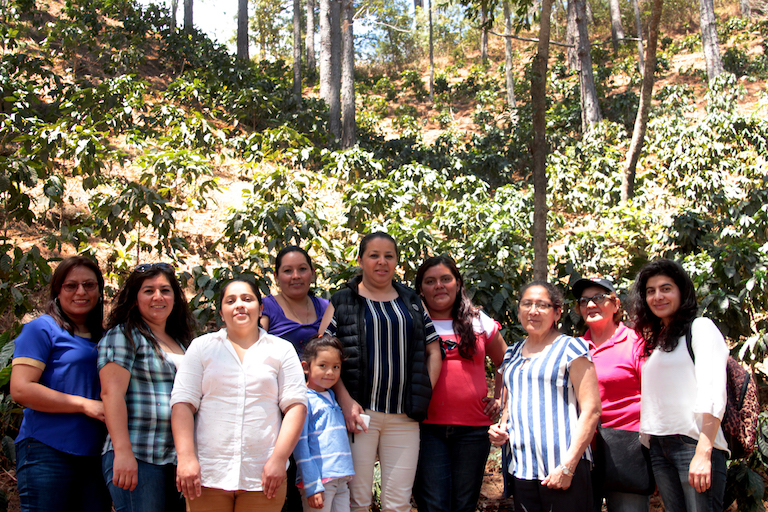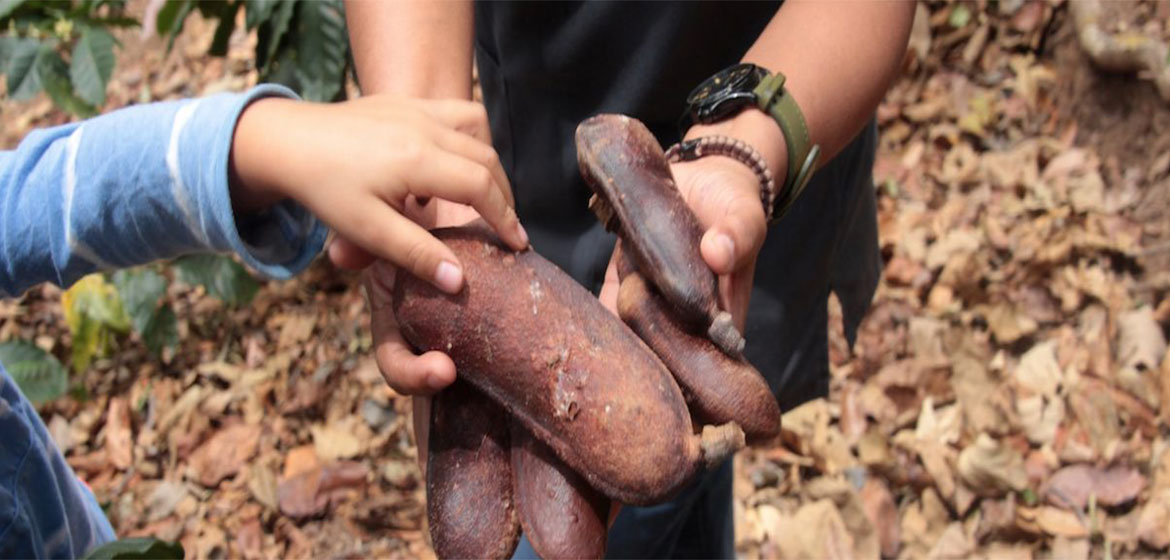By Monica Pelliccia
- The Lenca indigenous group in a dry region of Honduras has practiced agroforestry for millennia, planting timber and fruit trees over food and medicine crops to provide shade that increases soil humidity.
- Recently a group of women formed a cooperative to market their coffee grown in the shade of these trees as organic and fair trade, and they have enjoyed a sizable price increase.
- The Lencas’ agroforestry system also provides fruit and timber products that are ready for sale or trade during times of the year when the coffee crop is not ripe.
- Agroforestry is beneficial to the climate because it sequesters carbon from the atmosphere, and it also benefits biodiversity: the village has observed an increase in populations of animals like opossums, snakes, hares, armadillos, squirrels, birds and coyotes as the agroforestry plantings expand.
GUALCINCE, Honduras — The Lenca call it a sacrificial stone, where their indigenous ancestors went to make offerings to deities. A triangle of rock with different circles inscribed on its surface, it has remained intact despite the passage of time.
The woods that surround the village of Gualcince, almost at the border with El Salvador, bear marks of their past, too. It was here on Congolón Mountain that Indio Lempira, the famed Lenca leader of Honduran indigenous resistance, died. Lenca culture flourished here in the pre-Columbian epoch, and people still find ancient artifacts.

Despite the great depth of history, there are new traditions starting here as well. Amanda Abrego, a 36-year-old mother of four who lives near the sacred stone, is a board member of the cooperative of women coffee growers. Like 21 other female cafetaleras, she is now cropping organic coffee under the shadow of timber- and fruit-yielding trees, following the traditional system that the Lenca indigenous group — to which the famous environmental activist Berta Cáceres belonged before she was two years ago — developed before the arrival of Spanish conquerors, and they are selling it in a new way. In 2014, the women launched an all-female growers’ cooperative as a part of the Cosagual coffee growers’ organization.
Eva Alvarado, 60, is one of the founders of the cooperative. “All of my life I worked as a cafetalera,” she says. “When I was a girl, I was used to go by horse to sell coffee in El Salvador, 35 kilometers [22 miles] from here.” The idea of the cooperative was born after a workshop on gender equality organized by the Association of Non-Governmental Organizations (ASONOG), whose work was by Heifer International, a charity focused on tackling hunger and poverty. The aim was to bring the women of the community out of their houses, where they were mainly doing housekeeping and childcare, empowering them to develop their potential.
“I never imagined that I could be part of that, and I was elected the vice president of the cooperative,” Alvarado says. “Thanks to coffee, I paid the education for all my kids, and now my six grandchildren: this is the third generation that benefits from the work [of] our cooperative.”
Ancestors’ legacy
Alvarado’s organic farm is located at an elevation of 1,500 meters (4,920 feet), where coffee bushes are about to bloom in an explosion of white flowers. The bushes are organized under the shadow of fruit trees, such as plantain, orange, guamo (or “ice cream bean,” Inga feuillei), and timber trees like Spanish cedar (Cedrela odorata) and copinol (Hymenaea courbaril). With the kids, she has just started to collect guamo fruits — in late March, the fruits are ripe and ready to eat — as her neighbor Francisca Rivera is doing. After opening a green pod that protects the pulpy, rounded fruits, she eats one and saves the black seeds hidden inside for replanting, to produce more shade.

Alvarado, Rivera and their neighbors eat most of the fruit produced in their vegetable gardens and sell the extra to the local market. They sell part of the plantains to Amanda Abrego, who produces tajadas, or fried plantains, a typical food in Caribbean countries such as Honduras. After packaging the produce, she sells it to pulperias, little grocery shops in the nearby community. Tajadas are eaten as snacks or prepared with vegetables and slices of meat and seasoned with chili sauce. To cook, they use wood from the timber trees, like cedar and pine, which are large after 30 years of growth.
Their houses are also made of wood grown on the land. Among the coffee plants are bushes with white flowers locally called cangrejillo, which is used for animal feed, and guarumo (Cecropia obtusifolia), a medicinal plant used for treating insomnia and muscle pain.
Living in the Corredor Seco
The Cosagual community is located in the Corredor Seco, a dry region that runs through the south of Honduras, Guatemala and El Salvador, characterized by a shortage of rain. With the El Niño of 2012-2014, rainfall declined by 40 to 60 percent in this region, causing losses not only of coffee, but also of maize, beans and livestock. Lack of employment opportunities, and criminal violence, have pushed people to migrate from the region. Currently, 47 percent of families with one member who recently migrated are suffering food insecurity in this zone, .
“Agroforestry is a way to increase food security: the diversity of the crops on these lands allows an increase in production of fruit and vegetables that could be [traded] with other members of the community, or [provide] surplus sold to the market,” says Marcos Morales of the National Agricultural University in Olancho, who advises the agroforestry project. “Forest coverage and biodiversity increased: we observed animals such as opossum, snakes, hares, armadillos, squirrels and coyotes. Also, it is a way to counteract drought because soils retain more humidity.”

Morales lives in Gualcince, close to the Cosagual headquarters, and crops shade-grown coffee in a vegetable garden close to a patio full of flowers, where his mother is kneading a tortilla before cooking it in a clay oven. She is preparing the typical lunch, composed of beans, chicken and salad for some women of the community, who join the Morales family today to chat and tell jokes. Afterward, they visit Patricio Ramos, one of the oldest cafetaleros of the community, who takes care of little white-tailed deer in the garden, to save them from hunters. Marcos and the women move around the community in a pickup truck, passing through the wood, where birds such as woodpeckers and others known locally as chequeque (probably yellow billed caciques) peer out from the branches.
The oldest members of the community still remember when very few people in this zone used the slash-and-burn technique of farming. In the 1980s, the land was generally burned to potentially improve the fertility of the soils, but the practice brought with it the risk of forest fire and erosion. The farmers practiced a nomadic agriculture, but now there are no more traces of fires in these woods.
In 1988, the U.N. Food and Agriculture Organization (FAO) launched a project called in the valley near this area, with the aim of improving food security and recovering the biodiversity in this poorest zone of Honduras, where 85 percent of people were living in poverty and were undernourished. The FAO supported the revival of an ancient Lenca agroforestry technique called Quesungual (from the name of a village 9 kilometers, or 5.6 miles, from Gualcince), where shade-grown coffee is mixed with timber- and fruit-yielding trees pruned at 1.2 to 1.8 meters (4 to 6 feet) to shade the maize and beans. Now the all-female Cosagual cooperative trades fruit and timber with the farmers of the valley, in exchange for maize and beans.
techniques reduce soil erosion by up to 93 percent compared with slash-and-burn, and increase the retention of soil humidity by 20 percent, which is especially important during April, the driest month. Like other agroforestry systems globally, Lenca shade-grown ancestral agroforestry techniques also play an important role in combating . Annually, agroforestry sequesters around the world.

Scented dreams
“We keep dreaming big,” says Erlinda Martinez, 30, an administrator of the cooperative. “Cosagual coffee now is globally recognized. We are organic and fair trade certified: our prices don’t suffer from the oscillation caused by the stock market. We sell at a fixed price, higher than the one that we could have if we sell the coffee alone.” Before the formation of the cooperative, the cafetaleras had only one place to dry their fruit, and they had to sell their coffee to an intermediary who didn’t pay the full value for their top-quality organic coffee. But their coffee is now being exported all around the world, to different parts of the United States and Europe. Martinez, who has seldom ventured beyond Gualcince, had the rare chance to cross the Atlantic Ocean, when she flew to Budapest last year to participate in an international trade fair to find new business for the cooperative.
Every November, the members of the Cosagual Lenca cooperative collect the ripe coffee and deliver it to the cooperative, which manages the entire process, from drying to commercialization. Nothing of the coffee is thrown away: the waste from the processing is transformed into compost and distributed back to the community.
A good part of the work of the cooperative is to organize training on agroforestry techniques, administration and continuing the discussion on gender equality. Martinez is now busy preparing the next training session on institutional empowerment that will take place in May. The Cosagual cooperative just finished building a coffee bar at its headquarters, where the coffee is sold with rosquetes, a donut with frosting, and meringues, empanadas and sweet calzone. Another idea for preserving their traditions is to invite tourists and teach them about their ancient culture.

Challenges for the future
As in other rural and remote zones, this area is experiencing a process of depopulation. It takes more than three hours by car to arrive at Gualcince from the nearest city, San Juan Intibucá, in southeastern Honduras; electricity only arrived at the village 15 years ago. Most of the younger generation goes to the city to study for careers unrelated to agrarian production, with no plans to come back to the land. Yet the Lenca women are handing down their traditions to their kids, linking their past to their future, and passing along their folklore and the knowledge of their deeply rooted agroforestry system, which they call simply their “traditional technique.”
As the sun goes down, its last rays falling gently on the coffee crop, Amanda Abrego comes home and starts to cut plantains with her family, before frying them to prepare tajadas for sale. Meanwhile, kids are playing in the garden and run to the sacrificial stone, playing around it and telling each other stories about their ancestors, to preserve the memories written in the trees.
Source:
Related to SDG 5: Gender equality and SDG 8: Decent work and economic growth



